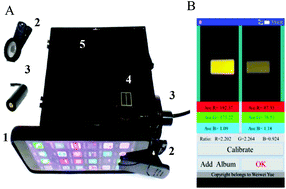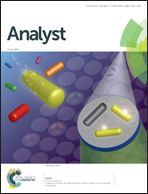A smartphone-based double-channel fluorescence setup for immunoassay of a carcinoembryonic antigen using CuS nanoparticles for signal amplification†
Abstract
Sensitive detection of cancer biomarkers is valuable for clinical diagnosis and treatment assessment of cancers. Herein, we report a simple smartphone-based double-channel fluorescence setup for immunoassay. Not including the smartphone, the total cost of the detection device itself is about 80 $, including a laser pointer, a twinning measurement cell, a collective lens, and an outside box. The fluorescence images of the sample and reference areas were captured by the camera in the smartphone and the brightness ratio was calculated using a user-edited smartphone app. By using 2,3-diaminophenazine (DAP) as the model luminophore, the influence of exposure time and photosensitivity on the sensitivity was tested. The brightness ratio offers high stability of the fluorescence signal, which is helpful to improve the sensitivity. The applicability of this device was demonstrated by a catalytic fluorimetric method for Cu2+ determination, which is based on the oxidation of o-phenylenediamine (non-fluorescent) to DAP (strong fluorescent) by dissolved oxygen using Cu2+ as the catalyst. Accordingly, by using a CuS nanoparticle-conjugated second antibody as the signal tag, the immunoassay for a carcinoembryonic antigen was performed with the detection limit of 0.05 pg mL−1. This smartphone-based double-channel fluorescence device offers the advantages of high sensitivity, inexpensive and miniaturization.



 Please wait while we load your content...
Please wait while we load your content...